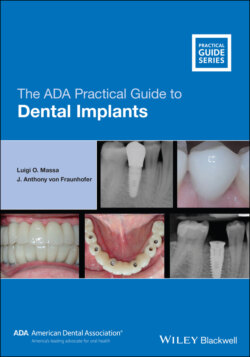Читать книгу The ADA Practical Guide to Dental Implants - J. Anthony von Fraunhofer - Страница 15
Implants vs Endodontic Treatment
ОглавлениеAlthough general dentists receive training in endodontics during their education, many prefer not to provide root canal therapy, particularly when surgical intervention is required. There are several reasons for this reluctance to perform surgical endodontics, not the least is the general perception of patients that “root canal therapy” is an unpleasant, long‐drawn out procedure that can be uncomfortable at best and at worst is painful. In fact, to a great many patients, the words “root canal therapy” are synonymous with any procedure or experience that is to be avoided at almost any cost.
In contrast, non‐surgical endodontic treatment is a predictable treatment choice if certain conditions are met. First, there must remain enough sound tooth structure to achieve a 2 mm ferrule effect 360° around the tooth. This will ensure long‐term stability of restorative treatments. Secondly, a cause‐and‐effect should be established when diagnosing a symptomatic tooth. For example, caries approximating a pulp horn with symptoms lead to a clear diagnosis of irreversible pulpitis. Conversely, a symptomatic tooth with no caries present leads to a less predictable treatment outcome until and unless a definitive diagnosis can be achieved.
When there is need for “root canal therapy,” the operator must have available a specialized armamentarium of instruments and restorative materials. However, it must be stated that the available instrumentation and endodontic sealer cements have improved dramatically over the past 20 or so years. Further, it is generally recognized that the time and expertise required to perform endodontic surgery increases almost exponentially with the number of tooth roots/canals to be treated. Additionally, when canals are sclerosed or calcified, there is increased difficulty in ensuring a clean and extirpated pulpal chamber and root canals.
Finally, teeth that have received extensive endodontic therapy tend to embrittle over time and are subject to failure under loading. Further, it is difficult to achieve a complete hermetic seal of a root canal so that apical leakage and ingress of bacteria, blood and other matter into the treated canal can occur over time. Coronal migration of tissue fluids and bacteria leaking into the treated root canal over time can have many untoward consequences, including dentinal staining, breakdown of sealer cements and restorations, pain and discomfort as well as infection. Due to risks associated with endodontically treated teeth, dentists are often reluctant to use these teeth as abutments for both FPDs and RPDs.
In contrast, the success rate of dental implants is 95–97%. This is far higher than treatment of symptomatic teeth with marginal ridge fractures and endodontic retreatment. These success rates must be considered when discussing treatment options, particularly when relative costs, patient time‐commitment to treatment as well as patient discomfort are considered in addressing the question of root canal therapy vs placement of an implant.
